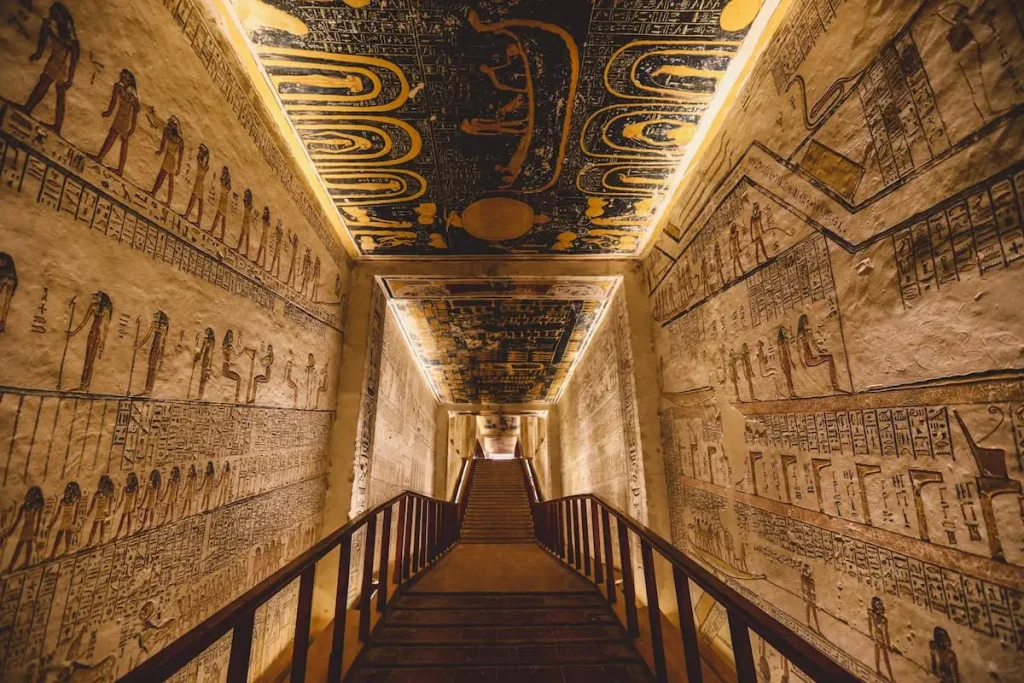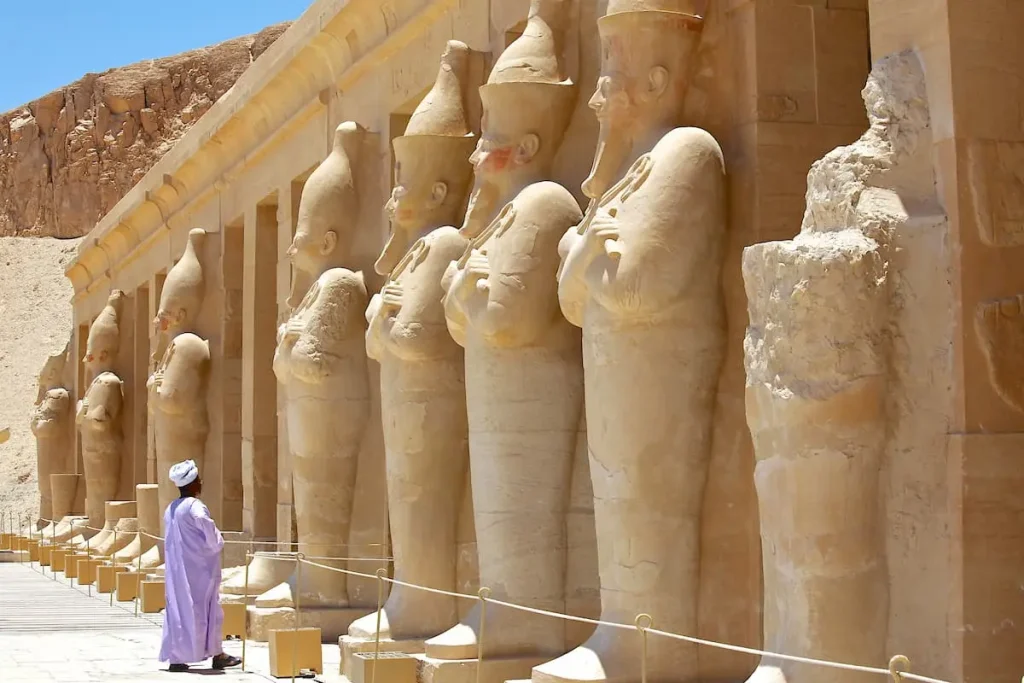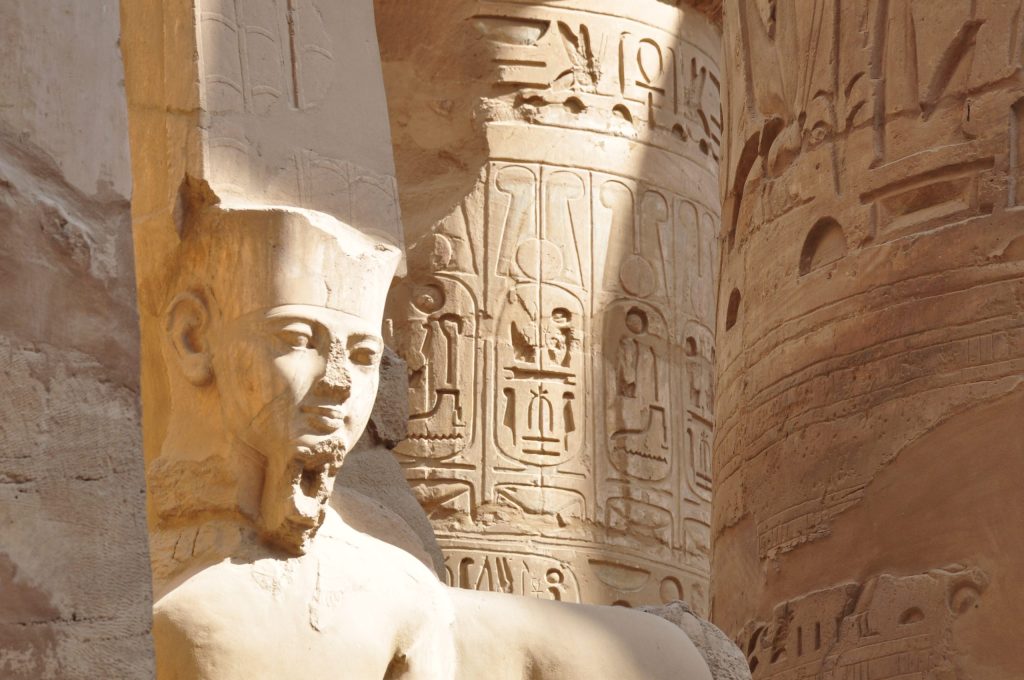Where is The Valley of The Kings
1Where Is the Valley of the Kings? A Guide to Egypt’s Royal Burial Site
The Valley of the Kings site competes with some of the best locations for the acknowledgment of a world historical treasure and has far-reaching fame. Additionally, situated on the west bank of the Nile at Luxor, this hidden-away valley was the royal necropolis for some New Kingdom pharaohs (1550–1070 BCE).
In the earlier dynastic times, kings were considered worthy for interment in pyramids; however, the rulers of this period were instead interred in rock-cut tombs that they had excavated from desert cliffs, perhaps to commemorate their sojourn in the divine realms and to conceal their treasures from the tromps of rampant tomb robbers. Moreover, these tombs opened a treasure house to archaeologists: art, rich hieroglyphic inscriptions, funerary texts, and countless artifacts illuminating ancient Egyptian belief systems, philosophies, and everyday life in general.
Some of the most wonderful kings were buried in the Valley of the Kings: Tutankhamun, Seti I, Ramses II, and Hatshepsut. Additionally, the opening of the tomb of Tutankhamun by Howard Carter in 1922 is reckoned as probably one of the grandest excavations in the history of Archaeology. Furthermore, the Western world was quite excited by the contents inside. Today, the Valley of the Kings is open to tourists and is one of the famous UNESCO World Heritage sites. Moreover, visitors can walk through corridors once meant only for the mightiest kings of Egypt and get a little taste of the mystic remains and immortal legacy left by the pharaohs.
Location of the Valley of the Kings
The Valley is located on the western bank of the Nile, with the contemporary city of Luxor in Upper Egypt lying across from it. Moreover, the locating of the place was quite intentional for the west was, in ancient Egyptian thought, the land of the dead. Moreover, the area of the valley, surrounded by adamantine cliffs of desert and cheerless little hills. Additionally, it was deemed to be a natural scene of majesty and seclusion for the funerary undertakings of those Pharaohs who were to be eternally separated from the hustle and bustle of daily life.
It was the hiding trails and natural rock formations, among other things, that aided in concealing the royal tombs from loss and theft. Furthermore, there is, looming above the site, its towering crest somewhat pyramid-shaped, the mountain called al-Qurn, or “The Horn,” believed by the ancients to be deliberately fashioned in the sacred pyramid shape associated with rebirth and the god Ra. With such symbolism nailed to the geography, the idea of the valley was hammered into popular concept as being an entrance to the afterlife.
Equally, with the desert entries and places being endowed with such spiritual meanings, the tombs would surely offer security as well, giving New Kingdom Pharaohs the chance of building the most elaborate underground resting places, wall paintings, funerary texts, and treasure-filled to aid in their journey into eternity.

Historical Significance of the Valley of The Kings
The Valley of the Kings has a special historical background, over the age of, it was in use as a burial ground of the pharaohs of the New Kingdom between the 16th and 11th centuries before Christ. The period corresponds with the expansion of Egypt to an empire, and the rulers of the 18th, 19th, and 20th dynasties, the so-called Empire or Late Period, looked for a long-lasting and protected place to be buried. In contrast to pyramids of the Old and Middle Kingdoms, which were plundered of their contents, the pharaohs of the New Kingdom preferred to construct detailed underground tombs cut out from the enclosed limestone cliffs of the Valley.
Many famous Egyptian kings, like Tutankhamun, Ramses II, Seti I, and Thutmose III, found here their final abode. What is unique about the kings’ tombs is that they were all painted and inscribed differently, with the walls constructed in such a way that funerary texts such as the Book of the Dead or the Book of Gates would be embedded for the king to safely reach the other side.
There are more than the Pharaohs’ burial chambers in the valley. Powerful men and women in the kingdom and their close relatives have been buried there. The fact that the valley is considered sacred and is known as the necropolis comes into its own immediately thereafter. Its excavation has given archaeologists, once in their history, the opportunity to study in such detail the Egyptian understanding of death, birth, and afterlife, and thus qualify it for being one of the greatest archaeological sites in the world.

Visiting the Valley of the Kings
The fascination of the Valley of the Kings multiplies with every waking day. This is a rare place to find in Egypt, where individuals from all over the globe travel and have their place of belonging. Coming from Luxor, and nestled in the lap of historic landmarks, the destination is rich in culture, presenting the beauty of Egypt in an ancient setting. Several royal tombs at the site are open to visitors, and each is an art of its own. In terms of mural paintings that have sequential decorations, every single detail will drive the visitor down the depths of the underworld. Among the oldest surviving illustrations of such murals that most significantly meet all the normative requirements of the time are the decoration of the tombs of the period mentioned.
It is worth acknowledging that there are more than 60 graves, although the fact that they are open to the public is a theory rather than a practice due to the overly regulated access. The tombs that make up part of the holding are quite remarkable, particularly the likes of the tombs of Ramses IV, Ramses IX, and Merenptah, yet the most popular tomb in the minds of most who come here is that of Tutankhamun.
The valley indeed contains a large number of pharaonic tombs and some of them the tombs are some tombs which include the most significant archaeology ever discovered. The tombs, among other spectacular features, catch the attention of numerous visitors. The modern tourism engineering provides an opportunity for these particular locations to be seen by anyone easily, as we have more than Falakiya.
Conclusion
As a result, it is important to note that the Valley of the Kings must be regarded as a treasured possession of Egypt because it brings together the past, the riddle, and the beautiful fabric of art under one roof. Situated on the Western side of the River Nile, whose eastern side is occupied by Luxor, it has accommodated several royal burials for the New Kingdom pharaohs in their attempts to change the conceptions of death and their understanding of life after death.
It has been built in the middle of nowhere in the desert in a record time and designed in a way that not only is a great evidence of the power of the ancient Egyptians but also opens a chapter of their beliefs about life after death. In accordance with the expectations of those who visit Egypt and who are in search of antiquity, the Valley of the Kings could undoubtedly be included in the list of attractions that reflect the greatness and mysterious civilization that has given the world so much over the years.






